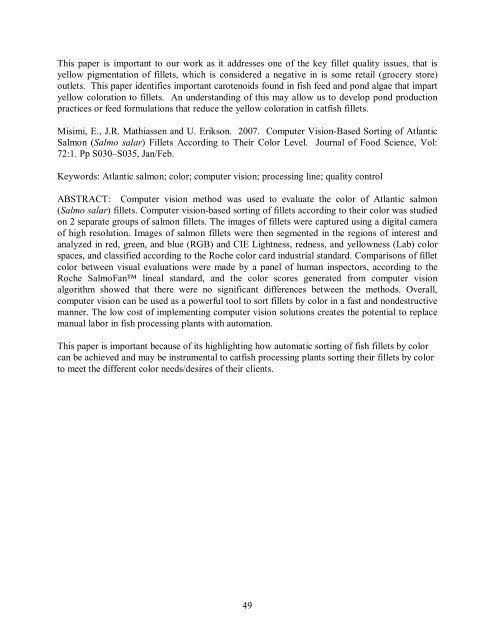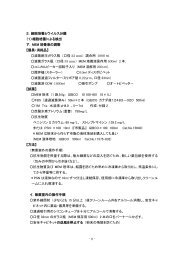Program and Abstracts(PDF)
Program and Abstracts(PDF)
Program and Abstracts(PDF)
Create successful ePaper yourself
Turn your PDF publications into a flip-book with our unique Google optimized e-Paper software.
This paper is important to our work as it addresses one of the key fillet quality issues, that is<br />
yellow pigmentation of fillets, which is considered a negative in is some retail (grocery store)<br />
outlets. This paper identifies important carotenoids found in fish feed <strong>and</strong> pond algae that impart<br />
yellow coloration to fillets. An underst<strong>and</strong>ing of this may allow us to develop pond production<br />
practices or feed formulations that reduce the yellow coloration in catfish fillets.<br />
Misimi, E., J.R. Mathiassen <strong>and</strong> U. Erikson. 2007. Computer Vision-Based Sorting of Atlantic<br />
Salmon (Salmo salar) Fillets According to Their Color Level. Journal of Food Science, Vol:<br />
72:1. Pp S030–S035, Jan/Feb.<br />
Keywords: Atlantic salmon; color; computer vision; processing line; quality control<br />
ABSTRACT: Computer vision method was used to evaluate the color of Atlantic salmon<br />
(Salmo salar) fillets. Computer vision-based sorting of fillets according to their color was studied<br />
on 2 separate groups of salmon fillets. The images of fillets were captured using a digital camera<br />
of high resolution. Images of salmon fillets were then segmented in the regions of interest <strong>and</strong><br />
analyzed in red, green, <strong>and</strong> blue (RGB) <strong>and</strong> CIE Lightness, redness, <strong>and</strong> yellowness (Lab) color<br />
spaces, <strong>and</strong> classified according to the Roche color card industrial st<strong>and</strong>ard. Comparisons of fillet<br />
color between visual evaluations were made by a panel of human inspectors, according to the<br />
Roche SalmoFan lineal st<strong>and</strong>ard, <strong>and</strong> the color scores generated from computer vision<br />
algorithm showed that there were no significant differences between the methods. Overall,<br />
computer vision can be used as a powerful tool to sort fillets by color in a fast <strong>and</strong> nondestructive<br />
manner. The low cost of implementing computer vision solutions creates the potential to replace<br />
manual labor in fish processing plants with automation.<br />
This paper is important because of its highlighting how automatic sorting of fish fillets by color<br />
can be achieved <strong>and</strong> may be instrumental to catfish processing plants sorting their fillets by color<br />
to meet the different color needs/desires of their clients.<br />
49



